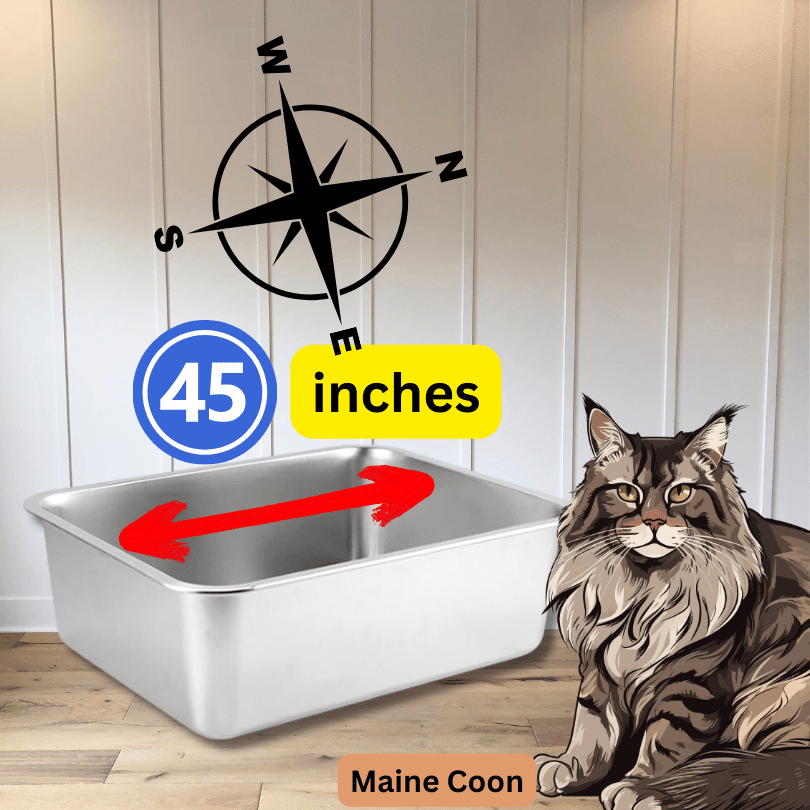
Here are five quick tips about cat litter trays and cat litter material. I won’t dwell on this subject too long. These are just my ideas. Each cat owner has their own.
Litter box material
Normally people buy litter trays and boxes made out of plastic. That’s perfectly normal and virtually all litter trays and litter tray covers are made out of plastic. I think we can do better than that by using a stainless-steel litter tray. The slight problem (or perhaps big problem) with a plastic litter tray is that it becomes scratched and it is hard to really clean the tray profoundly to avoid any buildup of bacteria or other pathogens in those scratches.
A litter tray should be a really hard material so that it can’t be scratched and I would advise spending a bit more and using a stainless-steel tray. Steel may also be better for the environment as plastic is made from petroleum.
Size of litter box
Another little tip which I have learned about over time is that the litter tray itself should be about 1.5 times the length of the cat from the nose to the base of the tail. In short, the litter tray should be big enough to accommodate a cat with ease and with some space to spare. This will help eliminate the problem of cats peeing and/or defecating over the edges. It may also limit the amount of litter dust which is walked out of the tray.
Covered or uncovered?
People discuss whether it’s best for a cat to have a covered or uncovered litter tray and I have always used a covered litter tray because it’s tidier and it keeps all the dust or litter substrate in. It looks better in a flat and it does help to retain the odour.
The issue with a covered litter box is that some cats might not like using it. This is where Jackson Galaxy, the American television celebrity and cat behaviourist comes in. He recommends that litter trays should be uncovered. Perhaps he recommends this because when a cat is at the toilet they are in a vulnerable position and if their toilet is fully enclosed there have no escape route. This might make some timid cats reluctant to use it. I have no hard evidence to support this but it sounds like a reasonable point.
Facing north and south
This is a peculiar one but it is thought that cats are good at finding their way home because they can sense the Earth’s magnetic field. And because of that superb sensitivity, it is said that a litter tray should be positioned lengthwise north to south! I have never complied with this suggestion but some people might like to try it if their cat is inappropriately eliminating. Incidentally, this suggestion is based on a research study concerning dogs which found that dogs are more comfortable when going to the toilet facing north and south and I have used that research to cautiously suggest that it might be applicable to domestic cats as well. Read that article by clicking here.
Litter material
I have an Infographic on another page about the litter substrate which provides basic information about the relative advantages and disadvantages of one against the other. You might like to refer to it when making your choices. My personal choices of the best overall is a wood-based cat litter pellet made from sawdust. It is not dusty and therefore the cat does not ingest clay dust which is highly dangerous.
It has good odour retention and it is highly absorbent. It does not clump but because the absorption is excellent, I don’t think that it needs to clump. I found that the litter tray itself is less likely to have loose urine in it compared to clumping litter which sometimes cannot cope with heavy peeing.
And the wood-based litter material is probably better for the environment because it comes from waste sawdust which is useful and it doesn’t have to be dug out of the ground in huge open mines which scar the landscape and destroys at least potentially the habitat of wildlife.
Also, it is more recyclable compared to clumping clay litter which really has to be thrown away with the general waste. Although you can’t compost cat faeces, you can compost used wood-based litter.
P.S. This might interest some purebred cat owners:


